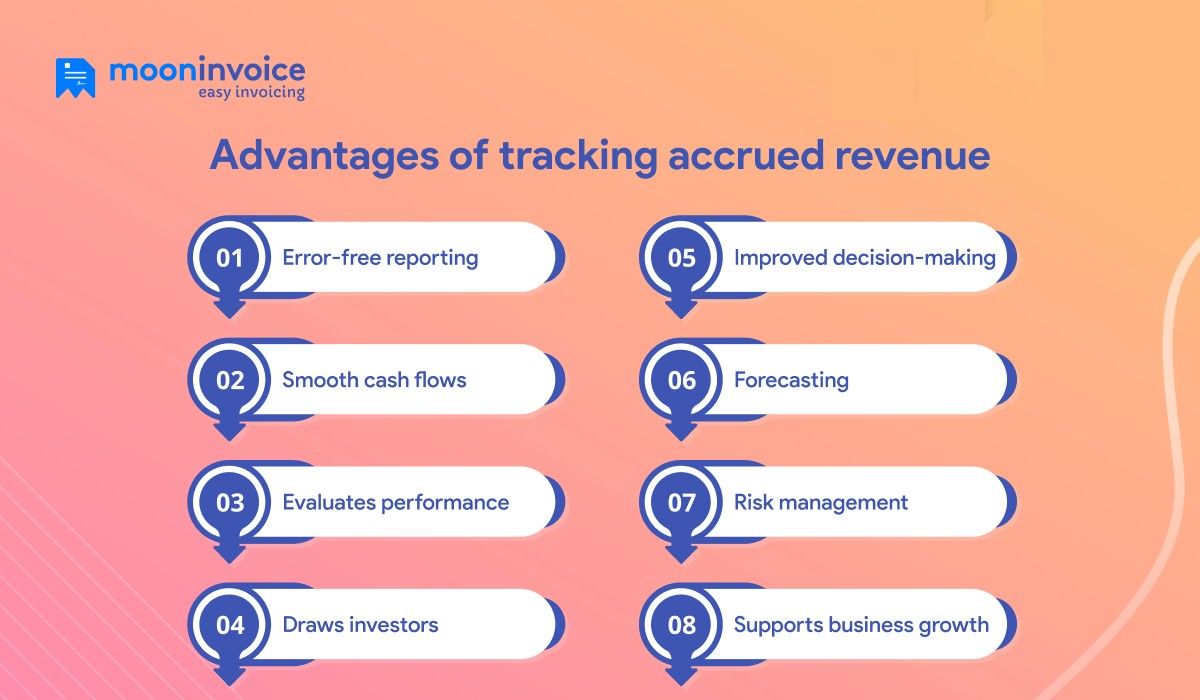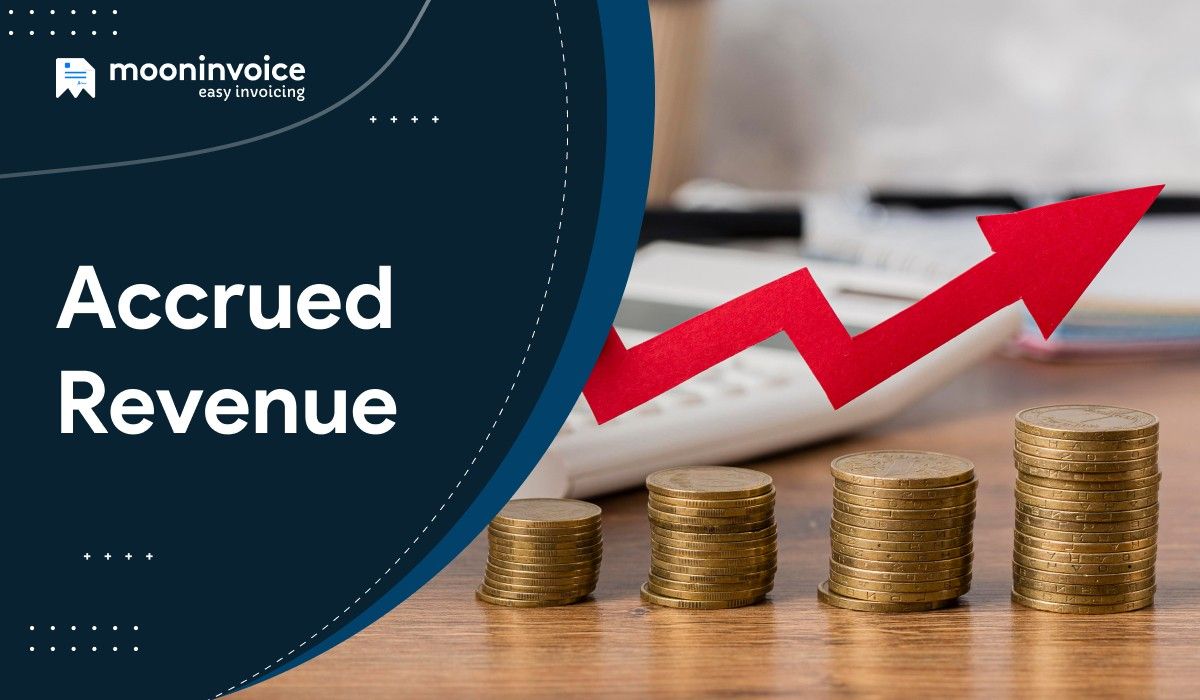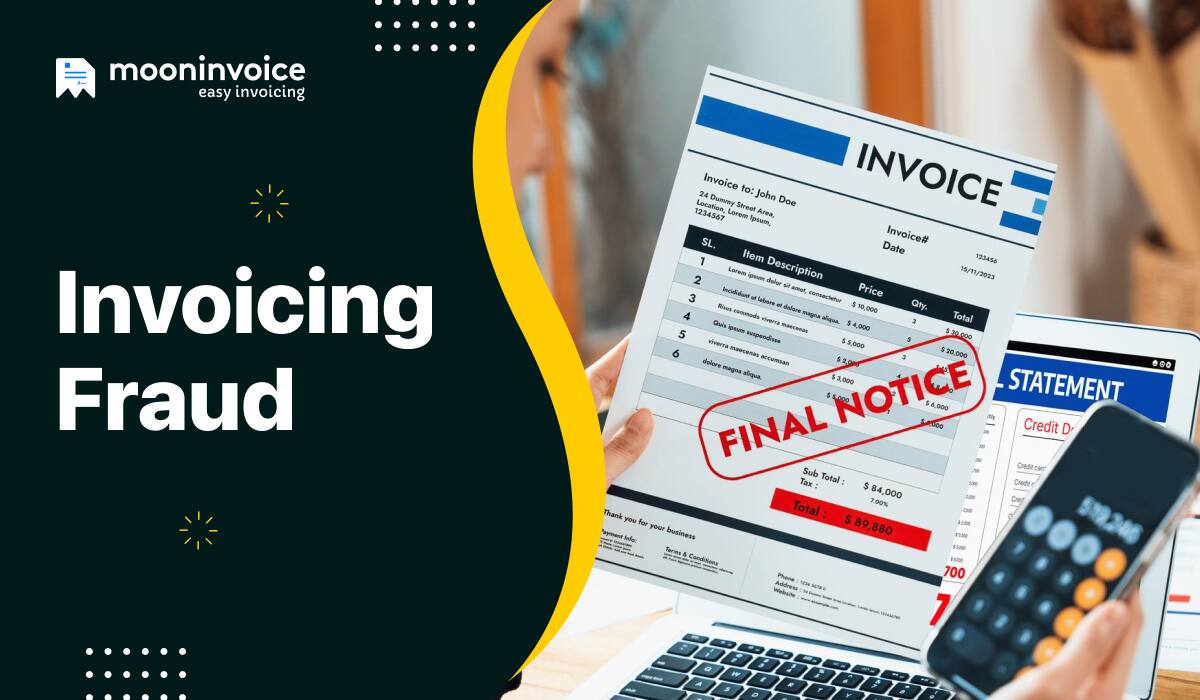Definition of Accrued Revenue
Accrued revenue refers to a company’s income where money is earned from delivering goods, but hasn’t been received yet from customers.
We know what it feels like when you put your heart and soul into something and still end up empty-handed. The pain of not receiving the money you have earned can’t be expressed in words, because you have already done your part, but the payment is still on its way.
That’s where accrued revenue steps in to keep an eye out for how much money is still pending from your customers. Because not every customer pays the money right after you finish the job. Some delinquent customers might take longer to clear their dues, impacting your daily operations.
Knowing how to record an accrued revenue journal entry will not only give an idea of how much cash is yet to hit your accounts but also aid you in forecasting finances to keep your operations running.
Alright, let us begin with the accrued revenue accounting definition first.
What Is Accrued Revenue?
Accrued revenue is an accounting term used when the company delivers the goods or services, but fails to receive the payments from its clients. It’s like they have earned the money following the completion of their job, but have yet to bill their clients.
Sometimes they may have sent an invoice, but the recipient has not cleared the bill. In such scenarios, the due money is termed as accrued income or accrued revenue.
Say, for example, a leading software company, Adobe, produces revenue mostly from subscription-based services. Once the user buys the annual subscription plan, the company lets them access all services immediately for a year.
However, Adobe recognizes that revenue gradually throughout the subscription period, meaning a portion of the income remains accrued until the service is fully delivered.
Does chasing payment feel like a never-ending struggle?
Let Moon Invoice take the wheel and help you receive 2x faster invoice payments, meaning you don’t have to wait for so long.
Accrued Revenue Explained
So far, you must have a basic idea about accrued expenses. But going deep down, it’s more than just “earned but not yet billed” income. It is something which mirrors your financial performance on your financial or income statement, no matter how soon the cash will arrive in your account.
This means that even though there’s a time gap between earning and receiving money, accrual accounting bridges it by recording the revenue in the same accounting period it’s earned. The amount falls in the current asset until your customer pays the invoice, in accordance with GAAP.
Similarly, things like interest or dividend income are classified as accrued revenue because the company has earned it, but the money will take some time to get credited into the account.
Hence, it’s more about tracking the money and gauging the performance rather than filling in the details on the statement.
Examples of Accrued Revenue
Let us take a couple of real-life examples to understand the accrued revenue accounting.
Example I – Service-Based Revenue Accrual
Imagine you are at the helm of a digital marketing agency, which delivers the service by completing a campaign project worth $11,400 for a client on the 30th of June. However, the invoice is sent on the 5th of July, the day when the actual billing cycle starts.
Therefore, when you close the books for June, the earned amount is recorded as accrued revenue, even though you have not yet billed the client.
Revenue accrual journal entry as of June 30th will be:
- Accrued Revenue (Asset): $11,400 Debit
- Service Revenue (Income): $11,400 Credit
This way, it makes sure June’s financial statements reflect the revenue the company truly earned. Once the invoice is dispatched in July, the accrued revenue account will then be reversed, allowing you to officially record the sale.
Example II – Revenue Accrual for Interest Income
Let’s assume your digital marketing company gave a loan to a startup business earlier and earned the interest of $1,240 on the 16th of September. You will get the full amount in the next month, i.e., on the 4th of October.
Since you already earned the revenue in September, below is how you will record revenue in the balance sheet for September month:
- Accrued Revenue (Asset): $1,240 Debit
- Service Revenue (Income): $1,240 Credit
Likewise, your September financial statements will show the interest income you earned, but the accrued revenue entry will only be reversed when you receive the full amount in the bank account, which could be in the month of April.
Why is Accrued Revenue Important?

Accrued revenue plays a notable role in fulfilling your financial reporting duties and forecasting incoming cash flows. Without it, you may find it difficult to see a clear picture of your financial health. Moving forward, it may impact your business operations and make your tax filing process prone to errors.
Below are a few benefits that underline why businesses should keep a tab on accrued revenue.
Benefits of tracking accrued revenue
- Error-free reporting
Accrued revenue is the reason behind generating accurate reports because it states what’s recorded as earned and what’s received. This helps you gauge your business’s performance without underreporting or overstating income.
- Smooth cash flows
Once you start tracking accrued income, you know what are your expectations. According to it, you can plan finances in a better way and then schedule outgoing cash flow wisely. This way, you can make sure you don’t disrupt the incoming or outgoing cash flow.
- Evaluates performance
Tracking accrued income can also assist you in evaluating your business performance. You can consider whatever you have earned and measure the actual company’s profitability based on the real data.
- Draws investors
Describing the accrued revenue in the balance sheet can draw investors as well. A benefit that is much sought after by businesses like yours. It provides transparency in the reports, like what you have earned and what you are expecting from others, fueling investors’ confidence.
- Improved decision-making
With accrued revenue, companies can make more informed decisions rather than just relying on guesswork. They can learn how much is earned till now and how much money is on its way when it comes to hiring resources or taking up more projects.
- Forecasting
If you are forecasting business finances, then tracking accrued expenses can provide much-needed help. It leaves no room for a guesstimate, but offers a clearer and bigger picture of how good is your business financial health.
- Risk management
Mitigating the risk factor is another perk you get when you start reviewing accrued income. You can learn which clients take longer to complete payments or identify the root cause of delays. It will aid in adjusting the cash flow plans and, hence, dealing with possible risks.
- Supports business growth
Business tracking accrued income can easily figure out how much money they will receive in the coming days. That said, it will help them in exploring growth opportunities and invest wisely in the near future, resulting in steady growth for your business.
How to Record Accrued Revenue
Below is what a 3-step process to follow when you want to record accrued income.
1. Recognizing the earnings
If you have services rendered or delivered the product but yet to receive the cash in hand, then make an entry to recognize what’s pending. At this stage, you also need to understand why the customer hasn’t paid the money or how soon they will make the payment.
Double-check whether you have issued an invoice. If not, ask your team to send an invoice so that you can close the matter as soon as possible. Hence, the first thing you must do is apply the revenue recognition principle to know the unpaid earnings before you move to the next step.
2. Revenue accrual adjustment
Once you have spotted how much amount you expect to be credited into your account, adjust the same in your accounting books. This marks a significant step in recording the accrued account because you make sure you have added whatever you earned, no matter if the action is pending from the client’s end or if you haven’t paid the bill.
The adjusting entry for accrued revenues further assists you in making reports, which are not just free from errors but also match the earned revenue in a specific accounting period. Following the revenue accrual adjustment, you can move forward to the last step if and only if the bill is paid.
3. Reversal of Accounts After Client Payment
Assuming that you have received the money in your bank account, now is your time to reverse the accounts. The last step follows the settlement of your invoice payment in order to update the earlier entries and clear the pending balance. Now, what you have to do is move the funds from the accounts receivable account to another column, i.e., cash or bank account, confirming that there are no more pending dues.
In more simpler words, what’s important here is to close the loop in a way that your accounts remain clean, free from duplication, and show your business’s real-time financial position.
Conclusion
As a business owner, you must comprehend and start tracking accrued income in a bid to get transparency and forecast finances. Here, we not only understood what is accrued revenue but also about how to record it in a 3-step way – recognize, adjust, and reverse the account.
At first glance, this accounting method may seem like a time-consuming process, but believe us, if you have an advanced accounting software, it won’t steal your time. You neither need to update details manually nor deal with minor errors.
It really helps you stay ahead of your reporting and tax filing duties. Well, don’t just take our word for it, go for a free trial and try it out yourself.




















